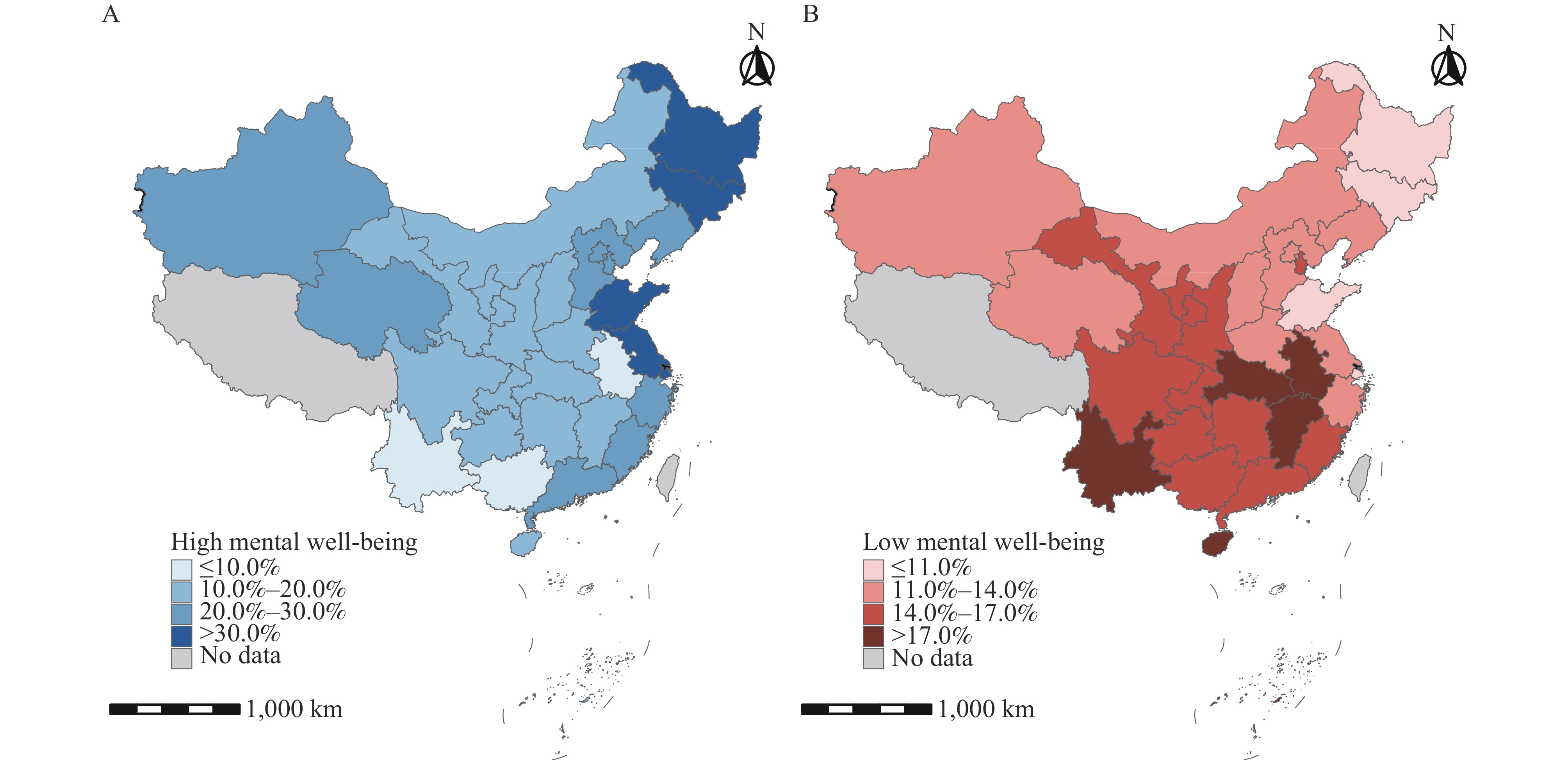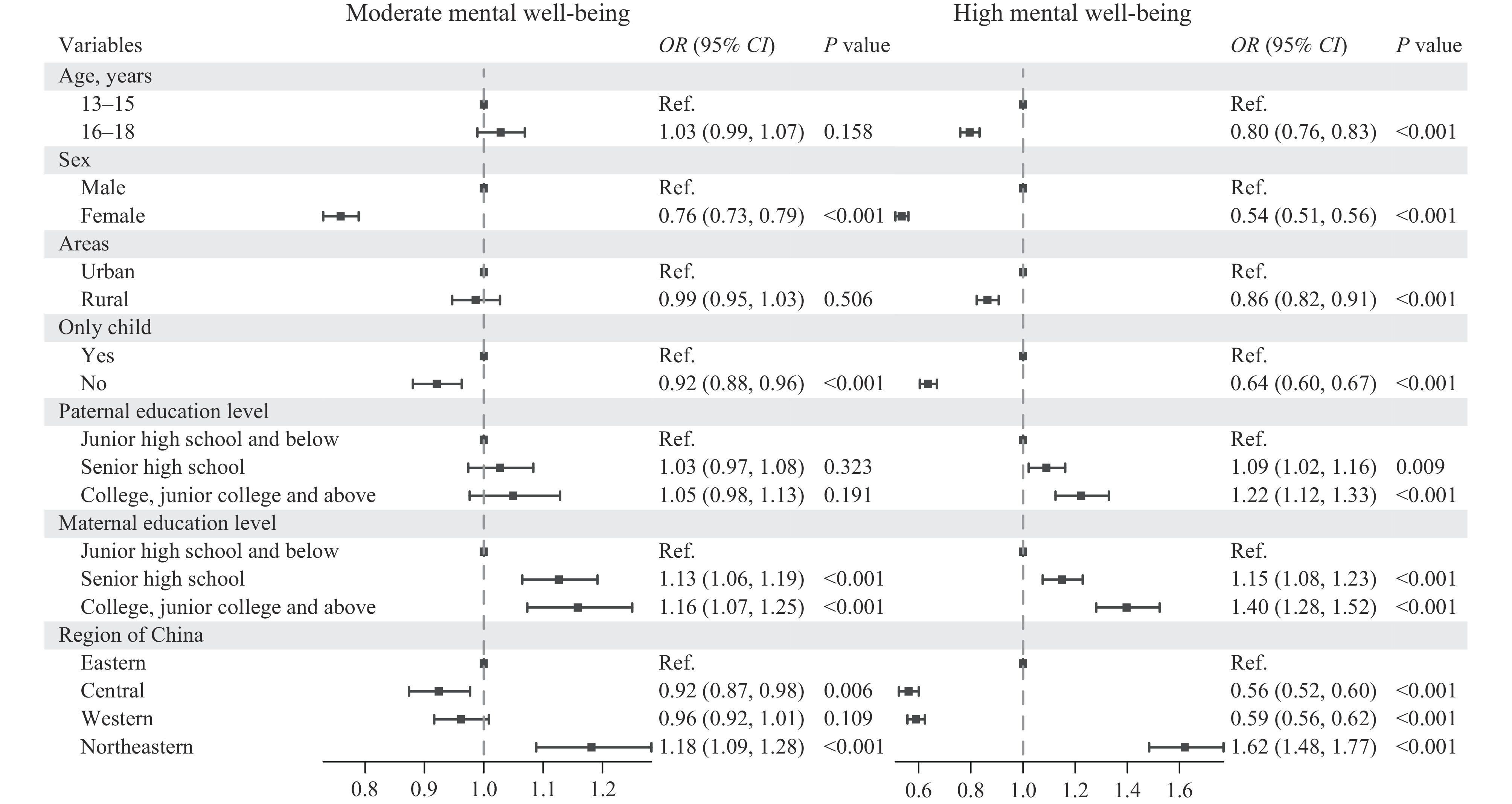-
Adolescence represents a crucial phase in physical, emotional, and psychological development. Research indicates that most mental health disorders begin in early adolescence (1). Mental well-being is recognized as a positive aspect of mental health (2), with high levels of mental well-being linked to numerous beneficial outcomes, including reduced psychiatric disorders, increased life expectancy, and greater life satisfaction (3). Despite this, past research has predominantly focused on psychiatric disorders, with limited studies exploring the prevalence and determinants of mental well-being. Consequently, this study seeks to determine the prevalence of mental well-being among Chinese adolescents aged 13–18 years and to examine the factors influencing it through a comprehensive cross-sectional survey conducted across all 30 provincial-level administrative divisions (PLADs, not including Xizang Autonomous Region) nationwide. The goal is to improve adolescent mental well-being and identify vulnerable populations to reduce disease burden.
Data were sourced from the 2019 Chinese National Survey on Students’ Constitution and Health (CNSSCH), which utilized a stratified cluster sampling method. To enhance representativeness, selection within each province was based on five criteria: regional gross domestic product (GDP), annual per capita income, per capita food consumption, population natural growth rate, and regional social welfare index. Provinces categorized their cities into three socioeconomic strata: upper, moderate, and low. One city from each stratum was randomly selected. Within these cities, middle and high schools were randomly chosen following established protocols, with sampling further differentiated by grade level. Classes were then randomly selected for survey participation. Data were gathered using a self-administered questionnaire focusing on adolescents aged 13 to 18 years. The study encompassed 30 PLADs, with a final sample of 99,788 participants after the exclusion of those with incomplete mental well-being scales.
The Warwick-Edinburgh Mental Well-being Scale (WEMWBS) was utilized to assess the mental well-being of adolescents, featuring a 14-item scale with each item scored between 1 and 5, yielding a total possible score range of 14 to 70. Higher scores are indicative of greater mental well-being. According to the classification based on the mean and standard deviation (SD) (4), scores below one SD from the mean (score <42) were considered indicative of low mental well-being, scores above one SD from the mean (score >63) suggested high mental well-being, and scores within these thresholds were categorized as moderate mental well-being. The reliability of the WEMWBS was confirmed with a Cronbach’s alpha coefficient of 0.949. Exploratory factor analysis revealed a Kaiser-Meyer-Olkin (KMO) measure of 0.962. The KMO measure assesses the adequacy of sample size for factor analysis, with values closer to 1 indicating a more suitable sample for the analysis. The analysis identified a single underlying factor with an eigenvalue exceeding 1, accounting for 60.349% of the total variance. Factor loadings for individual items ranged from 0.667 to 0.830.
Statistical analyses were performed using R (version 4.2.1, R Core Team, Vienna, Austria). Analysis of Variance (ANOVA) andχ2tests assessed differences in high and low mental well-being rates among adolescents with varied characteristics. Multinomial logistic regression identified factors influencing mental well-being. All tests were two-sided, using a significance threshold ofPvalue<0.05.
Table 1reports the characteristics of the participants included in this study. Overall, the mean (SD) score of mental well-being was 52.64 (11.26), with 20,957 adolescents (21.0%) classified as having high well-being, 64,471 (64.6%) as having moderate well-being, and 14,360 (14.4%) as having low well-being. A total of 50,877 adolescents aged 13 to 15 years (51.0%) and 48,911 adolescents aged 16 to 18 years (49.0%) were included in this study. The gender distribution comprised 50,176 males (50.3%) and 49,612 females (49.7%). Urban adolescents accounted for 50,386 (50.5%), while rural adolescents numbered 49,402 (49.5%).
Variable Total Mental well-being, No. (%) of participants Pvalue High mental well-being
(N=20,957)Moderate mental well-being
(N=64,471)Low mental well-being
(N=14,360)Age groups,n(%) <0.001 13–15 years 50,877 11,635 (22.9) 32,004 (62.9) 7,238 (14.2) 16–18 years 48,911 9,322 (19.1) 32,467 (66.4) 7,122 (14.6) Sex,n(%) <0.001 Male 50,176 12,228 (24.4) 31,861 (63.5) 6,087 (12.1) Female 49,612 8,729 (17.6) 32,610 (65.7) 8,273 (16.7) Areas,n(%) <0.001 Urban 50,386 11,676 (23.2) 31,816 (63.1) 6,894 (13.7) Rural 49,402 9,281 (18.8) 32,655 (66.1) 7,466 (15.1) Only child,n(%) <0.001 Yes 40,472 11,070 (27.4) 24,538 (60.6) 4,864 (12.0) No 55,856 9,033 (16.2) 37,822 (67.7) 9,001 (16.1) Missing 3,460 854 (24.7) 2,111 (61.0) 495 (14.3) Paternal education level,n(%) <0.001 Junior high school and below 49,835 8,785 (17.6) 33,324 (66.9) 7,726 (15.5) Senior high school 23,075 4,991 (21.6) 14,978 (64.9) 3,106 (13.5) College, junior college and above 21,344 6,076 (28.5) 12,823 (60.1) 2,445 (11.5) Missing 5,534 1,105 (19.9) 3,346 (60.5) 1,083 (19.6) Maternal education level,n(%) <0.001 Junior high school and below 53,754 9,511 (17.7) 35,874 (66.7) 8,369 (15.6) Senior high school 21,505 4,796 (22.3) 13,922 (64.7) 2,787 (13.0) College, junior college and above 18,766 5,525 (29.4) 11,161 (59.5) 2,080 (11.1) Missing 5,763 1,125 (19.5) 3,514 (61.0) 1,124 (19.5) Region of China,n(%) <0.001 Eastern 35,576 9,160 (25.7) 21,740 (61.1) 4,676 (13.1) Central 18,848 2,958 (15.7) 12,823 (68) 3,067 (16.3) Western 36,003 5,712 (15.9) 24,623 (68.4) 5,668 (15.7) Northeastern 9,361 3,127 (33.4) 5,285 (56.5) 949 (10.1) Table 1.Descriptive characteristics of the participants included in the study.
Figure 1illustrates the prevalence rates of high and low mental well-being among adolescents across various provinces in China. Jilin (39.6%), Heilongjiang (33.1%), and Shanghai (32.9%) report higher rates of high mental well-being, whereas Jiangxi (19.3%), Hainan (19.1%), and Anhui (18.9%) exhibit higher rates of low mental well-being.
 Figure 1.
Figure 1.Mental well-being rates of adolescents aged 13–18 across provinces in China, 2019. (A) High mental well-being. (B) Low mental well-being.
Map approval number: GS京 (2024)1369号.The findings from the multinomial logistic regression, depicted inFigure 2, indicate that several factors are associated with lower mental well-being among adolescents. These factors include older age [odds ratio (OR)=0.80, 95% confidence interval (CI): 0.76, 0.83], female gender (OR=0.54, 95%CI: 0.51, 0.56), residing in rural areas (OR=0.86, 95%CI: 0.82, 0.91), and not being an only child (OR=0.64, 95%CI: 0.60, 0.67). Additionally, higher levels of parental education correlate positively with improved adolescent mental well-being. This relationship is particularly pronounced with maternal education, where increased education levels are directly linked to enhanced mental well-being in adolescents.
 Figure 2.
Figure 2.Multinomial logistic regression analysis of the factors influencing mental well-being among adolescents aged 13–18 in China, 2019.
Note: Low mental well-being is used as the reference group.
Abbreviation: Ref.=reference;OR=odds ratio;CI=confidence intervals.
Additionally, compared to their counterparts in eastern provinces, adolescents in central and western provinces display reduced mental well-being, whereas those in northeastern provinces show enhanced levels. This pattern highlights the regional disparities in mental well-being among adolescents.
-
This study utilized a comprehensive, nationally representative dataset to examine regional disparities in the mental well-being of Chinese adolescents and to identify contributing factors. The findings indicate that the majority of Chinese adolescents display moderate to high mental well-being. However, despite this generally positive trend, consistent regional disparities highlight ongoing health inequalities among adolescents across different areas of China. These disparities may be attributed to variances in socioeconomic and environmental factors, including per capita gross domestic product, educational resources, and healthcare resources in different regions (5).
Age, gender, urban versus rural background, only-child status, and parental education level are crucial determinants of adolescent mental well-being. Studies indicate that older adolescents generally have poorer mental well-being compared to their younger counterparts, a phenomenon also documented in the United Kingdom, where younger adolescents are observed to flourish more frequently (6). Moreover, male adolescents tend to have better mental well-being, potentially due to different cognitive developmental trajectories during puberty and lower susceptibility to body image dissatisfaction, which tends to affect females more (7). Consistent with existing literature, adolescents from rural areas exhibit lower mental well-being, a situation often exacerbated by the high incidence of left-behind children who suffer from insufficient parental care (8).
A significant observation from our study is that only children tend to exhibit better mental well-being, possibly due to the dilution of resources as the number of children in a family increases (9). This suggests that the relaxation of China’s three-child policy could negatively affect the mental well-being of adolescents, underscoring the importance of heightened focus on adolescent mental health. Nevertheless, other studies suggest that having siblings may enhance mental well-being (10), which contradicts our findings. In light of China’s shift from a one-child to a three-child policy, additional research is imperative to explore and elucidate these discrepancies. Moreover, the educational attainment of both parents was positively associated with the mental well-being of adolescents, indicating a dose-response relationship. This highlights the critical role of family background and parental education in fostering favorable mental health outcomes in adolescents.
This study is subject to some limitations. First, the findings are based on self-reported data, which can introduce recall bias. Second, due to its cross-sectional design, this study cannot confirm causal relationships between variables. Finally, the analysis was limited to sociodemographic factors and did not consider other potential influences on mental well-being.
Our research provides a detailed examination and evaluation of the mental well-being of Chinese adolescents, filling a notable void in the available literature. By pinpointing crucial demographics and enacting specific preventive strategies, our findings are instrumental in achieving the United Nations Sustainable Development Goals (1). With an estimated 1.2 billion adolescents globally, prioritizing this group is essential for attaining Universal Health Coverage (1). Adolescent mental health is also a key focus of the “Healthy China Action Plan” (11), underscoring the necessity to address mental health concerns within this population. Our study emphasizes the need for region-specific interventions to improve the mental well-being of adolescents. There is a pressing need to enhance mental health support for adolescents in remote regions and among left-behind children. Actions required include expanding the workforce of mental health professionals, increasing the availability of mental health facilities, and providing adequate psychological assessment tools to advance the development of adolescent mental health services. Furthermore, improving parental understanding of mental health, fostering a supportive family atmosphere, and early detection of mental health issues are vital for promoting the mental health development of adolescents. This is particularly critical in families with multiple children, where the risk of mental health issues may be heightened. Acknowledging that the mental well-being of adolescents is integral to their overall life-long development, enhancing this aspect can substantially contribute to their comprehensive growth. In summary, our study highlights the critical need to place adolescent mental health at the forefront of public health initiatives to ensure their well-being throughout their lives.
-
No conflicts of interest.
-
All students and staff were involved in the survey.
HTML
| Citation: |




 Download:
Download:





